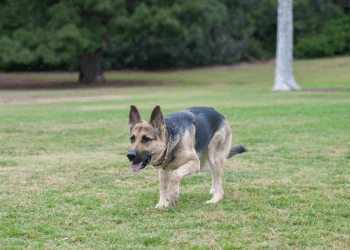Understanding Predatory Aggression in Dogs
Dogs are descended from predators which means that predatory aggression is part and parcel of who they are as a species. Not only that but dogs are selectively bred to do jobs like herding, helping people hunt and guarding. Those jobs mean that many dogs are selected for breeding based partly on traits that are linked to the predatory motor sequence. Since the 1800s, with showing dogs becoming popular, there is also a tendency to breed dogs for how they look. Even with that slight change, there are many dogs who continue to be bred to try and strengthen or maintain specific predatory traits. For many dogs, a strong interest in prey is key to the dogs being able to do that job they were bred to do.
That’s a long-winded way of saying that predatory aggression is normal for dogs – and in many cases, the traits that can lead to it are carefully selected for in breeding programs.
Key Characteristics of predatory aggression

When behaviourists are working to diagnose a specific type of aggression, they look for the dogs to be behaving in ways that would indicate that type. When it comes to predatory aggression, the following characteristics are looked for:
The dog is quiet during the attack.
There is no threatening behaviour such as barking, growling, teeth bared before the attack.
The dog may fixate on the target from a long distance away.
The dog stares at the target in a fixed way.
Sometimes dogs salivate before a predatory attack.
Stalking is often seen as the dog moves toward the target.
The target may be shaken in the attacking dog’s jaws or bitten badly enough to be seriously injured.
If the attacking dog gets to the target, their owner may find it hard to stop the attack.
Almost always with predatory aggression, the target will be wildlife, livestock, cats or birds.
You may have come across or been told about something called predatory drift that is said to trigger predatory aggression. Again, when the aggression is between dogs – particularly dogs who have been playing – predatory aggression is highly unlikely. There are better explanations for what is going when things go wrong between dogs.
Factors Influencing Predatory Aggression
You may have seen people describe some attacks on people or other dogs as being predatory and some of them will be. But – it is incredibly rare for dogs to direct predatory aggression at people or other dogs.
More likely causes for attacks that look predatory but where the target is a person, or another dog are:
Lack of socialisation prior to 12 weeks of age.
A previous attack or bad experience.
In some cases, particularly where the target is a person, poor attempts at protection training.
Dogs are all individuals, and many dogs are completely safe in spite of limited socialisation, in spite of bad experiences and in spite of unwise training. Some individuals are not, and they can go on to develop aggression that looks similar to predatory aggression. Scientists sometimes call that sort of aggression hyper-aggression because it is more intense than it needs to be.
Thinking about predatory aggression, several things influence whether or not it will be seen in an individual dog.
- Breed
-
Many dog breeds were initially created to encourage parts of the predatory motor sequence. For dogs of those breeds, a stronger interest in prey is often part of their character. That interest can make predatory aggression being more likely in dogs of those breeds.
Looking at your dog’s breed, what they were bred to do and how recently your dog’s ancestors were working at that job can be helpful. Researchers in Italy looked at the Dogo Argentino breed to understand the extent of aggression and fear in the breed. The breed is one that is banned in several countries due to concerns about aggression. The researchers noted that limiting breeding to dogs with less interest in prey may help to reduce aggression in the breed. However, their feeling was that since many Dogos are bred to assist hunters, it would be unlikely that breeders would significantly alter their practices to select dogs for breeding who had less interest in prey.
- Training
-
When it comes to predatory aggression training really matters. You might have heard that your dog’s interest in prey is genetic and so you can’t do anything about it – and that’s true. Their interest has a whole lot to do with their genes and their individual temperament.
Even so, there is plenty you can do with training to reduce the risks of predatory aggression. You absolutely can make a difference to what your dog does. Predatory behaviour is strongly influenced by learning. It has to be really because predators have to adapt their behaviour often as they try to catch food to eat.
What that means is that while you can’t take away your dog’s interest in prey, you can help them learn what to do with prey. People who have dogs to work with prey spend a whole lot of their time training their dogs. They train Border Collies not to chase too fast and to maintain control even in exciting situations. They train spaniels to find pheasants and then not chase them unless they are told to and to not grab them as they fly into the air – even though most dogs are fast enough to grab a pheasant as they get up into the air.
- Environment
-
Where you are with your dog will make a huge difference to how they behave toward prey. Even the weather and the time of year matter because those things impact on how wildlife and birds behave – and how able your dog will be to find them.
It is worth bearing this one in mind if you go on holiday with your dog or move house. You might well find that your normally reliable dog gets much more interested in prey. Or that your usually prey focused dog starts to focus more on you.
- Temperament
-
I know I’ve already mentioned this but it bears talking about again. Your dog’s individual temperament will play a huge part in how likely predatory aggression is for them. No matter what your dog’s breed is, do treat them like an individual and don’t be surprised if they develop an interest in prey even if their breed is labelled as having a low prey drive .
Differences Between Predatory and Aggressive Behaviour
Predatory behaviour is so associated with aggression that you might be surprised to learn that much of the predatory behaviour that dogs perform is not aggressive at all. Much of the predatory behaviour that dogs perform never gets to the stage of the dog attacking their prey.
Recent research into what dogs do when they are performing predatory behaviour found four phases in the behaviour. Only the final phase – the bite phase included an attack. Even there, one of the bites, the possess bite was usually seen when dogs were retrieving shot – and already dead – prey. In those instances, the aggressive behaviour came from the person who shot the animal or bird. There was no attacking by the dog.
Not only that but an old study from 1976 looked at the changes that becoming domesticated may have had on the instinct to attack and kill prey. The researcher worked with puppies between 8 and 9 weeks of age. The puppies were raised in a controlled way and had been weaned onto commercial dog food. They hadn’t even ever been fed fresh meat. For those puppies, prey had just not been part of their experience.

It was a small study with four beagle puppies, 17 puppies who were mixes of beagle and coyote and 13 coyotes. This is an old experiment and wouldn’t get ethical approval now, but animal welfare understanding was different in the 1970s which meant that the experimenter was able to observe each puppy in turn when the puppy was placed in an enclosure with a live rat.
Beagles are a hunting breed who use their nose to track prey for people. None of the beagle puppies killed the rats in any of the tests. They would sometimes play bow to them or get distracted and go off investigating the enclosure. They did not kill the rats. The researcher described similar sorts of behaviour as was talked about in the more recent research I mentioned above where the puppies would stab at the rats with their noses or leap toward them and then withdraw.
The coyote puppies killed and dissected the rats. Some of them too longer than others but they all attacked the rat they had access to.
The mix puppies bit the prey more quickly and shook it, but they inhibited their bites with only one of the puppies killing the rat in the first set of tests. Then two puppies killed the rat in the second set of tests.
Although this is an old study with only a small number of dogs, the results are consistent with the more recent and much larger observations into what dogs do with prey in a hunting context that I mentioned above. They looked only at dogs, and they saw no attempts to dissect or consume the prey. They did see some attacks on prey but not with every dog.
You may be nervous about your dog’s predatory behaviour because you’ve been told that it always leads to the dog aggressively attacking prey. For sure in some dogs, it does. My very first dog would catch, kill and eat rabbits – and sometimes birds too. It does happen, but it just doesn’t happen as often as you might have been led to believe. Even with those dogs, things aren’t hopeless. With training, my dog learned to leave birds and rabbits alone.

